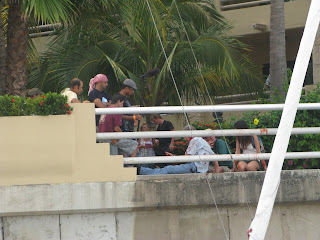Doug’s flight home was set for Friday. Sunday was spent relaxing, and going out to dinner with Michael & Laura. So there were 4 days to put the boat away. It was a busy 4 days – and somewhat nerve-wracking trying to decide exactly how to leave it – and how much time there was to do some of the tasks. Should I take the main off, or leave it on and covered? Should I take the halyards out to prevent sun damage? Well, no to both of those.
It seemed like a reunion in the marina - familiar boats included Laura, Juniata, Avalon, Overheated, Maradon, Jabiroo, Ahea Kali, Slacker, ... It was great to see so many familiar faces/boats in the marina - and to get advice and help from many of them as well as from new friends.
Tasks included: top up the fuel (used jerry cans from the nearby Pemex), clean the boat inside and out, clean head, clean out the frig, shut off propane, power off except bilge pump/alarm and solar panels charging, deploy double dock lines with fire hose chafe guard (thank you BFD) and spring lines, remove bimini canvas and dodger windows, secure dodger frame, cover main and wrap/tie a line around the cover, remove jib and staysail, secure lines on deck (furling lines, traveler etc), secure boom, remove wind generator (thank you Michael) and store below, secure anchors on bow, tie down winch cover and binnacle cover, store cushions below, store dinghy motor below, store dinghy and kayak below (thank you Phil & Katie), close thru-hulls, etc…


Hopefully it is well put away for the summer. I hired Tony to help look after the boat – regular topside and bottom cleaning, running engine, airing out, no bugs, etc.








































